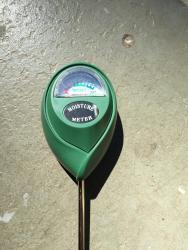Those meters are excellent and reliable, within reasonable limits. I used mine for a while to get an idea of how fast pots dry out. At this point I don't need it any more because I have learned through time and experience. You don't want to be jamming one of those in the soil every time you water because they will do damage to the roots over time. Once you get a sense of how things work, the meter renders itself unnecessary. You can calibrate the readings to your finger readings, or better yet wait to repot one of your plants until it is dry or nearly dry (pick the setting, wherever you want them to end up), then confirm the meter is reading a moisture level that agrees with what you can see with your own eyes.
There's no reason to fault the meter for one plant having different needs from another. And there's no reason to fault the meter for not watering thoroughly (to completion). My plants are almost all succulents and I let the vast majority go dry or mostly dry, every time. You don't ever need to soak pots in a bucket to rehydrate dried out soil. Instead, water in two or more passes, separated by a few minutes. The first pass, the soil gets a little bit moist. Then the second pass it can absorb more water. Once you get an idea of the holding capacity of any given container, you can be pretty efficient doing this. The reason it makes a difference is that peat (like other organic fibers) does not absorb water efficiently when it is bone dry, only when it is moist.
If you want to test this, you can try an experiment. Allow a given pot to dry out all the way. Then water it until water comes out the bottom. Try not to pour on too much excess water, so the results will be easier to interpret. Allow that water to completely exit the bottom of the container into a saucer, and move the container to a new dry saucer. Take a 5 or 10 minute break. Then come back and pour that water (plus whatever may have seeped out during the break) back on top of the soil. How much of it gets absorbed? How much passes through the second time? You may be surprised by the results. They will be more dramatic in larger pots.
